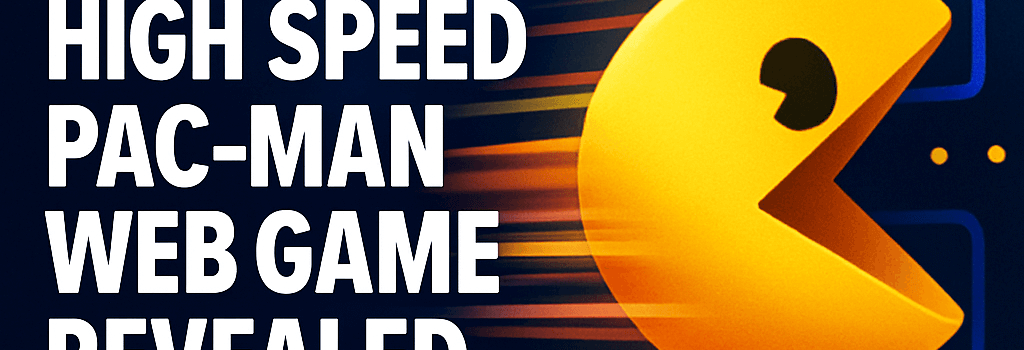YouTube’s High-Speed Pac-Man Web Game Revealed

Introduction
The original Pac-Man remains one of the most enduring classics of arcade history, enshrined in the inaugural class of the Strong Museum of Play’s World Video Game Hall of Fame. Yet today’s players, accustomed to lightning-fast mechanics and dynamic level design, may find the 1980 release somewhat sedate. Enter Pac-Man Superfast, an officially licensed, high-octane twist built into Google’s own YouTube platform—a mod delivered via the nascent YouTube Playables web-gaming initiative.
Discovering YouTube Playables
Few have noticed YouTube Playables since its quiet rollout last year. Positioned under a new “Playables” tab, the program hosts nearly 200 HTML5-based titles. Built on standard rendering APIs (Canvas 2D, WebGL, and WebAudio), it represents Google’s post-Stadia gamble to keep casual gamers engaged in-browser.
- Launch date: October 2024 (beta in select regions)
- Tech stack: JavaScript ES6+, WebAssembly modules for complex logic, IndexedDB for local high-score storage
- Integration: YouTube iframe API, allowing overlays and occasional video ad triggers
Despite rumors of deeper integration with Chrome OS and the Google Play ecosystem, the platform remains experimental. YouTube’s official FAQ labels it “an experimental feature rolled out to select users in eligible regions.”
Pac-Man Superfast: Gameplay and Speed Progression
Pac-Man Superfast takes the original maze and quartet of ghosts but transforms the pacing into a nerve-shredding reflex test. Speeds automatically ramp up over time:
- Easy (baseline arcade speed)
- Fast (+10% velocity every 10 seconds)
- Superfast (archival top speed)
- Crazy, Insane, Maniac
- Doom (peak challenge mode)
Dying temporarily drops your speed multiplier, but a rapid respawn puts you right back into the fray. The result? A relentless acceleration that dwarfs even the acclaimed Pac-Man Championship Edition series.
Technical Architecture of Playables
Under the hood, YouTube Playables relies on a modular JavaScript engine:
- Rendering: WebGL2 with fallback to Canvas for older browsers
- Physics & Logic: WebAssembly modules compiled from C++ to maintain sub-millisecond collision checks
- Audio: WebAudio API for dynamic sound effects synchronized to speed thresholds
- Input: Keyboard, touch events (swipe), and partial gamepad API support (USB controllers currently unrecognized)
This architecture balances performance and compatibility, targeting 60fps on desktop Chrome, Firefox, and Edge. Preliminary benchmarks show GPU utilization peaks at 30–40% on integrated Intel Iris GPUs at top speeds.
Performance Metrics and Expert Insights
“By offloading pathfinding to a WebAssembly module, the developers keep JavaScript’s main thread free for rendering and input polling. It’s an elegant solution for browser-based arcade ports,” says Ada Nguyen, a veteran HTML5 game engineer.
Stress tests indicate:
- Average frame latency: ~12ms at “Doom” speed
- Memory footprint: ~25MB resident in Chrome
- CPU load: ~15% on 6-core Intel i7 CPUs
These metrics confirm that even high-speed maze logic can run smoothly in a standard browser environment without dedicated hardware acceleration.
User Experience, Accessibility, and Limitations
Despite its technical prowess, Pac-Man Superfast has design quirks:
- Fixed 13-level cap, preventing marathon 256-level runs classic to original Pac-Man
- No bonus for unused extra lives or endurance, limiting high-score incentives
- Absence of built-in leaderboards; high scores can only be shared manually
Accessibility options are minimal: players cannot remap controls or adjust color contrasts, which may hinder users with motor or visual impairments. However, the inclusion of swipe and keyboard controls does offer a degree of flexibility.
Future of Browser-Based Gaming on YouTube
With Google rumored to be exploring AI-driven in-game assistance and deeper ties to YouTube Shorts, YouTube Playables could evolve beyond casual flash titles. Recent filing patents suggest possible integration of real-time game analytics and personalized difficulty scaling through machine learning models hosted in Google Cloud.
If these initiatives materialize, we may see a next generation of web games—complete with matchmaking, cloud saves, and adaptive tutorials—launched directly on the world’s largest video platform.
Conclusion
Pac-Man Superfast is a remarkable hidden gem within YouTube Playables. Its expert use of modern web APIs, combined with the nostalgia of classic Pac-Man gameplay, makes it well worth a few coffee-break sessions. While it falls short on extended level design and social features, its lightning reflex challenge remains compelling—especially for developers and retro enthusiasts curious about the technical boundary between browser and arcade.
Excellent blog! Do you have any tips for aspiring writers?
I’m planning to start my own blog soon but I’m a little lost on everything.
Would you recommend starting with a free platform like WordPress or go for a
paid option? There are so many choices out there that I’m totally overwhelmed ..
Any recommendations? Appreciate it!
Experience tһe best laser hair removal Richmond аt HSA Dermal Clinic
for smooth, hair-free skin.
I’m really enjoying the theme/design of your website. Do you ever run into any web browser compatibility
issues? A few of my blog visitors have complained about my website not operating correctly in Explorer
but looks great in Safari. Do you have any solutions to help fix this problem?